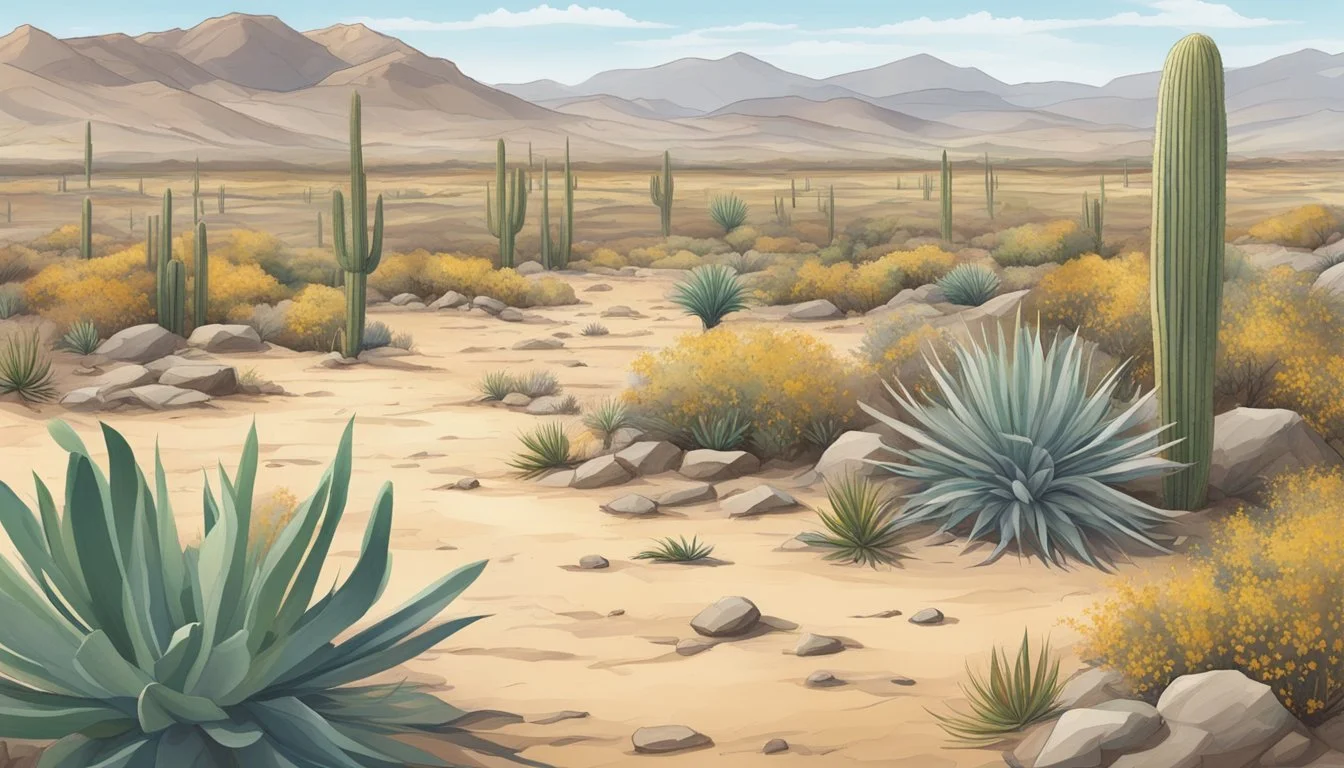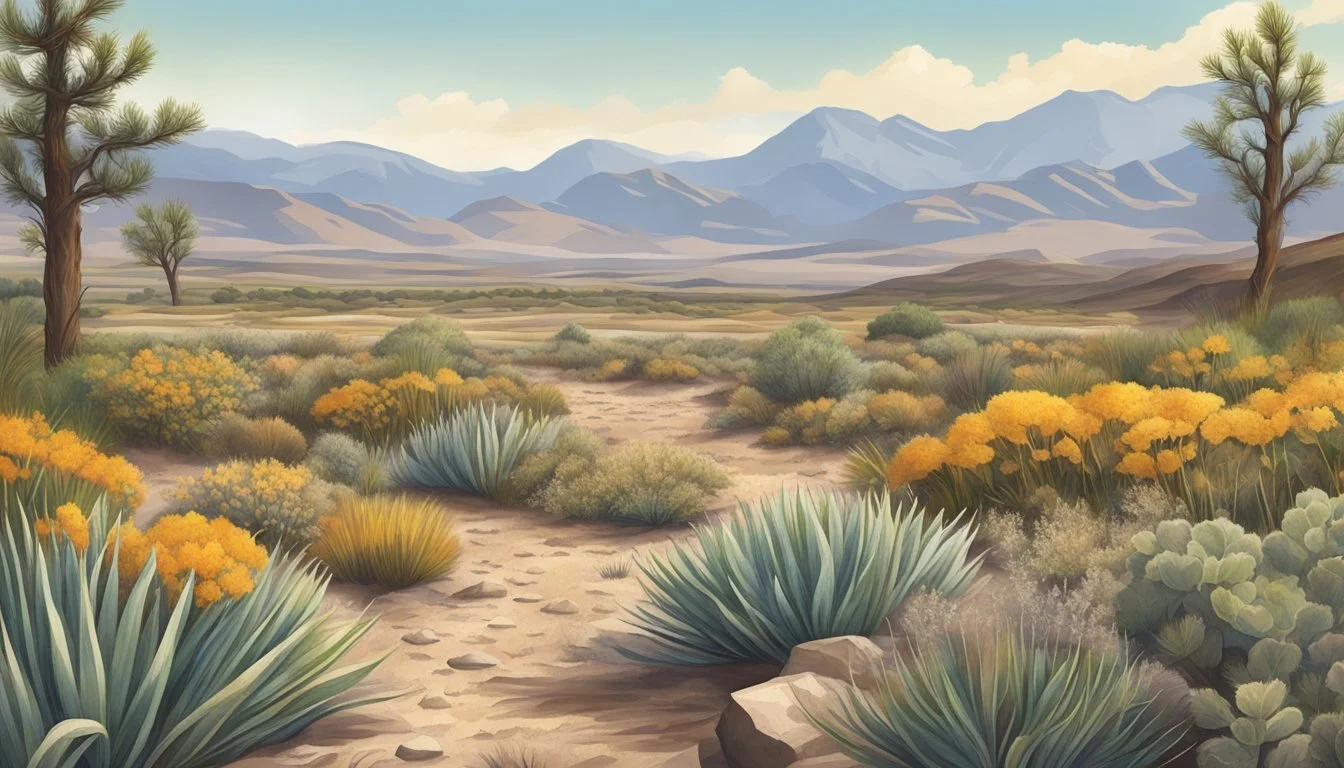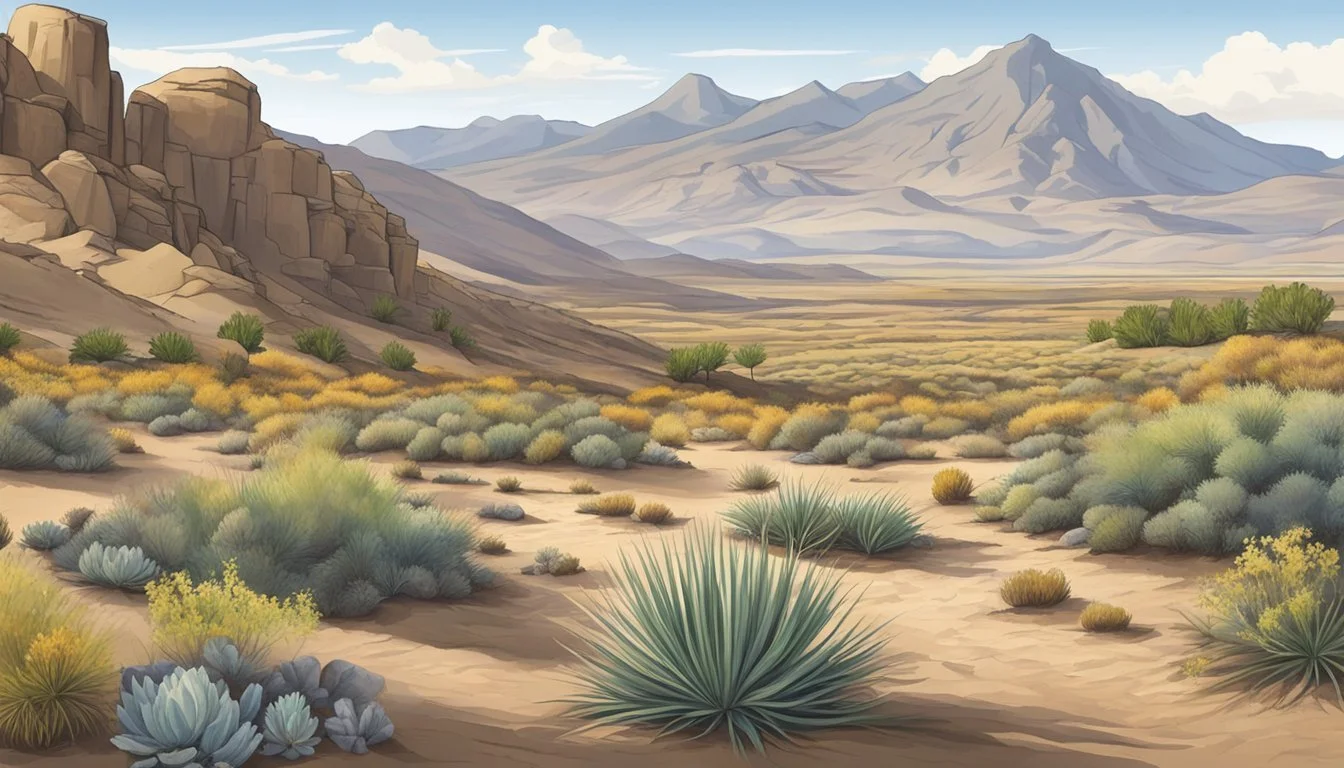Drought-Tolerant Plants in Montana
Top Choices for Resilient Landscaping
Montana's diverse climate presents unique challenges for gardening and landscaping, especially with the increasing prevalence of drought conditions. Adapting to these dry periods requires the use of drought-tolerant plants that can thrive with minimal water. These plants are not only practical for water conservation efforts but also help maintain a vibrant and healthy ecosystem. They are often native species that are well-adapted to Montana's specific environmental conditions, which include cold winters and hot summers.
Landscaping with drought-resistant flora is an effective strategy for gardeners and farmers alike. Plants that are suited to dry conditions can reduce the need for irrigation, a crucial consideration in areas where water is at a premium. Additionally, these plants can contribute to biodiversity, offering habitat and food sources for local wildlife. Some examples of drought-tolerant plants include the quaking aspen and the narrowleaf cottonwood, both of which have adapted to Montana's climate.
Understanding Drought and Its Impact on Landscaping in Montana
Drought is a significant climate challenge in Montana, characterized by lower than average precipitation leading to water scarcity. It profoundly affects various aspects of life, including landscaping, which is integral to the state’s aesthetic and environmental health.
Landscapes in Montana face unique challenges due to the semi-arid climate. Gardeners and landscapers must often consider drought-resistant plants for sustainable practices. Effective landscaping strategies can mitigate drought’s impact, conserving water while maintaining vibrant gardens.
Montana's climate necessitates the use of drought-tolerant plants. Landscapers are tasked with selecting species that can thrive with minimal water. Plants like big sagebrush and chokecherry are native to Montana and have adapted to thrive in its dry conditions.
Native Plant Advantages:
Require less water
Lower maintenance
Better survival rates
The use of drought-resistant landscaping ideas not only conserves water but can also create visually appealing spaces that reflect the natural Montana landscape. Incorporating such plants into garden designs results in resilient and sustainable landscapes that can better withstand fluctuating climate conditions.
It’s crucial for residents, landscapers, and planners to understand and prepare for the impacts of drought. Adaptive management tools are available, such as the Montana Drought Management Plan, which provides strategies for dealing with drier conditions.
In summary, understanding how drought affects landscaping in Montana leads to more informed choices in garden planning, showcasing a commitment to environmental responsibility and resource conservation.
The Fundamentals of Drought-Tolerant Planting
In Montana's variable climate, the selection of drought-tolerant plants can be crucial for a sustainable garden. These plants have adaptations that enable them to thrive in conditions where water is scarce. To establish a garden with drought-resistant flora, there are several vital components to consider.
Firstly, native plants are often a wise choice. They are naturally acclimated to Montana's local conditions and thus generally require less maintenance. When planning a drought-tolerant garden, one should contemplate the existing soil conditions. Soil rich in organic matter can retain moisture more effectively and provide nutrients that help plants to manage stress.
Proper exposure to full sun or shade also plays a significant role. Some drought-resistant plants prefer full sun, developing extensive root systems that seek out moisture. However, other species may need partial shade to conserve their water usage and protect them from drying out.
Below is a brief guide on how to approach the planning and planting process:
Choose native plants: Embrace species that are indigenous to Montana to ensure better adaptability and resilience.
Condition the soil: Amend soil with compost to enhance water retention and support plant health.
Placement is key: Organize plants according to their light and shade preferences to optimize their natural drought resistance.
Water wisely: Even drought-tolerant plants require water to establish themselves. They should be watered efficiently, focusing on less frequent but deeper irrigation to promote root growth.
Understanding these fundamentals of drought-tolerant planting lays the foundation for a flourishing, low-maintenance garden that can withstand the challenges of Montana's dry periods.
Selecting the Right Plants for Montana's Climate
Montana's diverse climate demands careful consideration when selecting plants for landscaping. Given the state's varying weather conditions, gardeners are advised to consider drought-tolerant, hardy native species to ensure a resilient garden.
Shrubs and Trees
When selecting shrubs and trees for Montana's landscape, it is essential to opt for species that can withstand its often dry conditions. Chokecherry and Juniper are two such native shrubs that not only survive but thrive in Montana's climate, providing important habitat for local wildlife.
Chokecherry (Prunus virginiana)
Wildlife attraction: Birds and butterflies
Care requirement: Low
Juniper (Juniperus spp.)
Wildlife attraction: Birds
Care requirement: Very low
Perennials and Flowers
The perennial garden in Montana is graced by hardy wildflowers like Echinacea (particularly the Purple Coneflower), Penstemon (commonly known as Beardtongue), and Blanket Flower. These flowering plants offer a vibrant display while needing minimal water, making them ideal for resource-conservative gardening.
Echinacea (Purple Coneflower)
Benefit: Attracts pollinators
Penstemon
Benefit: Attracts hummingbirds
Blanket Flower (Gaillardia)
Benefit: Long blooming period
Grasses and Groundcovers
The backbone of a drought-resistant landscape is often made up of grasses and groundcovers. Fescue grasses and Yucca are notable for their ability to survive with little moisture while contributing texture and movement to the garden.
Fescue (Festuca spp.)
Ornamental variety: Blue fescue
Maintenance: Low
Yucca
Feature: Evergreen rosettes
Maintenance: Extremely low
Vines and Climbers
While less common in arid climates, certain vines and climbers are viable for Montana gardens. It's crucial to select varieties that can handle the thermal extremes and reduced water availability, although options may be more limited compared to other plant categories.
Note: Seek local expertise for the best cultivars of these types of plants, as personal consultation can lead to better success in the garden.
Designing a Drought-Resistant Landscape
Designing a landscape resilient to dry conditions involves a strategic selection of plants and thoughtful layout to minimize water usage while maintaining aesthetic appeal. This approach incorporates features like garden beds, rock formations, and careful slope management to achieve a low-maintenance and sustainable outdoor space.
Garden Beds and Borders
Garden beds and borders in a drought-resistant landscape often consist of native Montana plants like coneflower, blazing star, and black-eyed Susan, which require minimal irrigation. One can layer these with mulch to retain soil moisture and suppress weeds.
Layout: Arrange plants in groups based on water needs
Soil: Amend with organic matter to improve water retention
Rock and Xeriscape Gardens
Xeriscaping and rock gardens are effective landscaping ideas, utilizing a variety of rocks and stones to reduce water consumption. These gardens feature a mix of succulents and grasses that thrive in arid conditions.
Materials: Use a combination of pebbles, gravel, and larger stones
Plants: Select those adapted to rocky soils, such as yucca and sedum
Slopes and Hillsides
Landscaping on slopes and hillsides presents challenges, but with terracing and the use of drought-resistant shrubs and groundcovers, one can prevent soil erosion and reduce water runoff.
Terraces: Build stepped levels to slow water flow
Planting: Choose deep-rooted plants for stability and moisture retention
Water Features and Accents
Water features like birdbaths or fountains should be incorporated sparingly and designed to recirculate water. Accents such as dry river beds made from smooth river rock add aesthetic interest without increasing water demand.
Design: Opt for solar-powered pumps to conserve energy
Accents: Integrate decorative yet functional elements like a rain garden to manage runoff
Caring for Drought-Tolerant Plants
Caring for drought-tolerant plants in Montana involves specific strategies to ensure these plants thrive despite the state's varying climate conditions. These plants generally require less maintenance than others, but adhering to best practices can promote healthier growth and conserve water.
Soil Preparation and Improvement
To support drought-tolerant plants, soil preparation is crucial. Incorporating compost can enhance the soil structure, helping retain moisture without waterlogging the roots. A well-draining soil mixture prevents excess water from accumulating, which is essential during Montana's growing season when rain can be sporadic.
Add Organic Matter: Mix ample compost into the garden beds.
Test Soil Drainage: Ensure the water drains at an appropriate rate, indicative of a well-constructed soil base.
Watering and Conservation Strategies
Even plants with low water requirements benefit from strategic watering. Establish a water efficient routine during the early morning or late evening to minimize evaporation.
Water Deeply but Infrequently: This encourages deep root growth.
Drought-tolerant Plants: They are adapted to thrive with minimal watering once established.
Mulching and Ground Coverage
Mulch is a gardener's ally for conserving moisture, reducing weed growth, and maintaining an even soil temperature. Materials like wood chips or straw act as an excellent mulch for drought-tolerant gardens.
Apply Mulch: Around plants to a depth of 2 to 3 inches.
Choose Groundcovers: They can conserve water by shielding the soil from direct sunlight.
Managing Sun Exposure
Most drought-tolerant plants require full sun to perform best. Nevertheless, in the intense Montana summer, part shade can prevent scorching for some species.
Select Plants Suited for the Exposure: Ensure they match Montana's typical sunlight levels.
Monitor Plants: For signs of stress from too much sun and provide shade if necessary.
Enhancing Biodiversity with Drought-Tolerant Gardens
Creating drought-tolerant gardens is a decisive step toward enhancing biodiversity, especially in regions like Montana where water conservation is paramount. Native plants are particularly effective for these gardens as they are well-adapted to the local climate and soil conditions. They require less water once established and provide essential habitat for wildlife, including pollinators such as bees and hummingbirds.
These plants typically offer a variety of flowers, seeds, and berries that are attractive food sources for many species. Grasses and shrubs create shelter and nesting areas, vital for maintaining a healthy ecosystem. Establishing such an environment not only supports existing wildlife but also attracts new species, making a garden a vibrant hub for biodiversity.
Consider incorporating these drought-tolerant plants for a Montana garden:
Purple coneflower (Echinacea purpurea): Attracts bees and butterflies.
Yarrow (Achillea millefolium): Offers a landing spot for various pollinators.
Blanket Flower (Gaillardia): Provides nectar for hummingbirds and butterflies.
By choosing a diversity of plants, gardeners can ensure a continuous bloom period, providing resources throughout the seasons. Having a variety of flowering times helps to support a wide range of pollinators that might visit the garden at different times of the year.
Moreover, water-wise practices like mulching and proper soil preparation can further reduce water usage, while still fostering a lush environment for local wildlife. Such gardens serve as proof that conservation and beauty can coexist, and they play an integral role in supporting the local ecosystems.
Eco-Friendly Practices in Drought-Tolerant Landscaping
In the face of changing climate conditions, drought-tolerant landscaping in Montana has become an imperative practice. Landscape ecologists recommend several eco-friendly techniques that cater to water conservation while supporting local ecology.
Native Plants: Incorporating native plants into garden design is essential. They are well-adapted to the local climate and soil conditions, thus requiring minimal water beyond natural rainfall. A garden with native species respects the natural ecology, reduces water usage, and offers habitats for local wildlife.
Organic Matter: The inclusion of organic matter such as compost enriches the soil. It improves water retention and provides essential nutrients to plants, reducing the need for synthetic fertilizers. This not only aids in water conservation but also contributes to a more robust and self-sustaining landscape.
Mulching: Applying a layer of mulch around plants prevents water evaporation, regulates soil temperature, and deters weed growth. This ensures that plants maintain moisture even during hot, dry periods, and soil organisms flourish.
Efficient Irrigation: Switching to drip irrigation systems or soaker hoses enhances water efficiency. These methods deliver water directly to the plant roots, minimizing wastage through evaporation or runoff.
These practices exemplify how gardeners and landscapers in Montana can achieve a drought-resistant landscaping approach. With a commitment to sustainability, Montana's landscapes can remain verdant and vibrant even under the constraints of limited water availability.
Plant Selection by Region
Selecting the right plants for a garden in Montana requires consideration of the region's diverse climate. From the cold winters in the mountainous regions to the milder conditions in the valleys, each area has native species best suited for local conditions.
Plants for Western Montana
In western Montana, gardeners have a variety of native species that are well-adapted to the region's conditions. Echinacea angustifolia, commonly known as Narrow-leaf coneflower, is a drought-resistant plant that flourishes in various settings from plains to woodland openings. It's praised for its tall stature and pink blooms that attract pollinators. Another excellent choice is Gaillardia aristata or Blanketflower, a forb recognizable by its vibrant red and yellow blooms that thrive in dry conditions.
Plants for Plains and Valley Regions
The plains and valley regions of Montana are characterized by open spaces and occasional short floods, for which grasses like Leymus cinereus (Great Basin Wildrye) are ideal. This bunchgrass grows up to six feet tall and is effective for erosion control. It is also adaptable to moist and dry conditions, making it a versatile option for the region. In addition to grasses, drought-tolerant flowering plants such as Gaillardia (Blanket Flower) also perform well, creating a low-maintenance yet vibrant display.
Common Challenges and Solutions
In Montana, cultivating drought-tolerant plants can lead to encounters with various environmental stressors. Successfully growing these plants requires an understanding of the challenges presented by pests, extreme weather, poor soil conditions, and competition for resources.
Dealing with Pests and Diseases
Drought-tolerant plants can still fall victim to pests and diseases. To mitigate these issues, gardeners should opt for deer-resistant species to deter browsing animals. Implementing integrated pest management strategies can control insect populations. For diseases, one should select plants with known resistance and ensure proper spacing for air circulation.
Surviving Extreme Weather Conditions
Drought-tolerant plants in Montana must also endure extreme climate variations, including frost and intense sunlight. Mulching helps protect roots from temperature extremes. When a sudden frost threatens, covering the plants with cloth or frost blankets can provide necessary protection.
Coping with Poor Soil Quality
Soil in Montana can suffer from being heavy, poorly drained, or saline. It's crucial to match plants with appropriate soil types, improving growing conditions by amending the soil with organic matter. Regular testing can detect and address deficiencies before planting.
Avoiding Overcrowding and Competition
To avoid overcrowding and competition, gardeners must be strategic about plant spacing and species selection. They should group plants with similar water, light, and soil requirements. Regular thinning of plants ensures that drought-tolerant species have enough space and resources to thrive.
Frequently Asked Questions
In this section, readers will find concise answers to common questions regarding the cultivation of drought-tolerant plants in Montana's unique climate. Emphasis is placed on native species known for their adaptability to low-water conditions.
What are the best native perennials for drought-prone areas in Montana?
Montana's drought-prone areas benefit from native perennials such as Blanket Flower (Gaillardia aristata) and Purple Coneflower (Echinacea purpurea), which are celebrated for their resilience and minimal water requirements. These species contribute to a water-efficient garden.
Which drought-tolerant shrubs are recommended for Montana landscapes?
For Montana landscapes, the Curl-leaf Mountain Mahogany (Cercocarpus ledifolius) stands out as a remarkable choice among drought-tolerant shrubs, offering both aesthetic and ecological benefits.
What low-maintenance plants thrive in Montana's dry conditions?
Grasses such as Bluebunch Wheatgrass (Pseudoroegneria spicata) and June Grass (Koeleria macrantha) are low-maintenance plants that not only thrive in Montana's dry conditions but also provide texture and movement in the garden.
Can you suggest some drought-resistant native Montana flowers for a garden?
A garden in Montana can flourish with drought-resistant native flowers like the vibrant Lewis Flax (Linum lewisii) and the hardy Bitterroot (Lewisia rediviva), which add splashes of color and are adapted to the local conditions.
What are some hardy plants for dry conditions that are native to Montana?
Plants such as the Yarrow (Achillea millefolium) and Rocky Mountain Penstemon (Penstemon strictus) are recognized for their hardiness in dry conditions and their ability to thrive in Montana's challenging climate.
How can I landscape with native Montana plants to minimize water usage?
Landscaping with native Montana plants to minimize water usage involves selecting species that are naturally adapted to the local environment, such as those listed in drought-tolerant landscaping ideas for Montana, and implementing design strategies that reduce the need for water, like xeriscaping.










